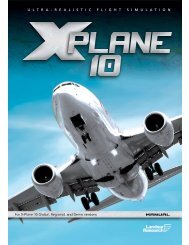Download the Plane Maker Manual - X-Plane
Download the Plane Maker Manual - X-Plane
Download the Plane Maker Manual - X-Plane
Create successful ePaper yourself
Turn your PDF publications into a flip-book with our unique Google optimized e-Paper software.
4<br />
Working with <strong>the</strong> Aircraft’s Systems<br />
An aircraft’s systems include electrical, hydraulic, fuel, avionics, flight control, and propulsion subsystems.<br />
In addition to influencing <strong>the</strong> flight model as appropriate, <strong>the</strong>se systems can be set to fail<br />
in X-<strong>Plane</strong>, allowing pilots to practice dealing with contingencies.<br />
4.1 Creating <strong>the</strong> Engines<br />
The aircraft’s engine, along with any related propellers, thrusters, and so on constitute its propulsion<br />
sub-system.<br />
To begin creating an aircraft’s engine, open <strong>the</strong> Standard menu and click Engine Specs. The<br />
Location tab of <strong>the</strong> Engine Specs dialog box is <strong>the</strong> best place to start. There, you can set <strong>the</strong><br />
number, type, location, and o<strong>the</strong>r properties of both <strong>the</strong> engines and propellers. The parameters<br />
available here will vary depending on what type of engine(s) you choose.<br />
To begin, set <strong>the</strong> number of engines present on <strong>the</strong> aircraft using <strong>the</strong> box at <strong>the</strong> top of <strong>the</strong><br />
dialog box. A number of columns will appear, one for each engine you specified. Use <strong>the</strong> drop down<br />
menu at <strong>the</strong> top of each column to set <strong>the</strong> type of each engine. The engine type will determine<br />
what fur<strong>the</strong>r parameters are available for <strong>the</strong> engines. It will also affect, among o<strong>the</strong>r things, <strong>the</strong><br />
sounds produced by <strong>the</strong> engine and <strong>the</strong> fuel flow it draws.<br />
The following types of engines are available here:<br />
• carb recip-an internal combustion, reciprocating (piston) engine used to drive a propeller. It<br />
uses a carburetor to mix air with fuel at low pressure.<br />
• injected recip- an internal combustion, reciprocating (piston) engine used to drive a propeller.<br />
It uses a fuel injector to mix air with fuel at high pressure. Fuel-injected engines are far more<br />
common today than carbureted ones, due partly to <strong>the</strong>ir increased reliability.<br />
• turboprop (free)-an internal combustion, gas turbine engine used to drive a propeller. Gas<br />
turbines are more reliable than reciprocating engines. A free turboprop engine is one whose<br />
power turbine is not geared to <strong>the</strong> gas turbine’s compressor, allowing <strong>the</strong> propeller to operate<br />
independent of <strong>the</strong> compressor speed. This is <strong>the</strong> most common turboprop design.<br />
• turboprop (fixed) -an internal combustion, gas turbine engine used to drive a propeller whose<br />
power turbine is geared to <strong>the</strong> compressor.<br />
46














